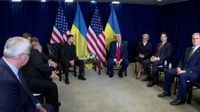On October 11, 2025, the world watched as U.S. President Donald Trump and Ukrainian President Volodymyr Zelensky held a pivotal phone call, one that could reshape the trajectory of the war in Ukraine. For about 30 minutes, the two leaders discussed the possibility of supplying Ukraine with the long-range Tomahawk cruise missiles—a move that, if realized, could dramatically shift the balance of power in the region and escalate tensions between Washington and Moscow.
According to Axios, which cited two sources familiar with the conversation, the call was initiated as part of ongoing efforts to bolster Ukraine’s defenses against Russia’s ongoing invasion. The Tomahawk missile, a staple of U.S. military might, is capable of hitting targets up to 1,500 miles away with precision. This means that, in theory, Ukrainian forces could strike deep into Russian territory, including Moscow itself—a prospect that has both excited Kyiv and alarmed the Kremlin.
President Zelensky was effusive in his assessment of the conversation. On October 11, he called the exchange “very positive and productive,” remarking on social media that the leaders had discussed “opportunities to bolster our air defense, as well as concrete agreements that we are working on to ensure this. There are good options and solid ideas on how to truly strengthen us.” He added, “I received the necessary signals that the US is considering ways to strengthen our cooperation. We are grateful for this.” (Axios, UPI, Nova News)
Notably, the topic of Tomahawks is not new between the two presidents. During a closed-door meeting at the United Nations General Assembly in September 2025, Zelensky pressed Trump to lift what he referred to as “any taboos” on arms deliveries. The Ukrainian leader’s pitch was clear: the mere presence of Tomahawks in Ukraine’s arsenal could, in his view, force Russian President Vladimir Putin to “sober up a bit—sit down at the negotiating table.” As Zelensky explained to Axios, “It might not even be necessary to actually use the missiles: simply having them available could provide leverage to force Putin to negotiate.”
For Ukraine, the Tomahawk is more than just another weapon. Kyiv has long sought to acquire these missiles, viewing them as a potential gamechanger in a war that has so far seen the country largely reliant on shorter-range weapons and drones for its long-range strikes. As a senior congressional aide told UPI, “They would scare the s–t out of the Russians more than almost anything else we could do.” The missiles’ range and precision make them especially capable of hitting hard targets—arms depots, oil refineries, and military bases—that have so far remained largely out of reach.
But as with so many matters of war and peace, the decision is far from simple. Trump, for his part, has been characteristically cautious. Earlier in the week, he stated, “I have sort of made a decision” on whether to supply Tomahawks to Ukraine, but he emphasized that he first wanted “to find out what they’re doing with them”—a nod to concerns that such a move could escalate the conflict even further. Trump has floated the idea of selling Tomahawks to NATO countries, who would then transfer them to Ukraine, but he has insisted that the final decision rests with him. (Axios, Nova News, UNN)
U.S. Vice President J. D. Vance echoed this cautious approach, noting that Washington is considering the possibility of transferring Tomahawks to NATO for onward supply to Ukraine, but that “the final decision remains with Trump.” Meanwhile, Ukraine Foreign Ministry spokesperson Heorhii Tykhyi described the talks as “very detailed and active,” and said that technical coordination between the two countries is already underway. “Right now, there is no ‘no’ response,” he explained at a briefing, adding that both sides are working out the specifics of the request, including the forms and configurations in which the missiles might be provided. (RBC, Axios)
The stakes, of course, are enormous. Russian President Vladimir Putin has not minced words about the potential consequences. On October 12, he warned that supplying Tomahawks to Ukraine would constitute “a completely new, qualitatively new phase of escalation.” The Kremlin has threatened to shoot down any Tomahawk missiles delivered to Ukraine and to destroy their launch sites. Putin has also cautioned that such a move could “ruin relations between Washington and Moscow”—a threat that has not gone unnoticed in diplomatic circles. (Reuters, Nova News)
For Zelensky, the stakes are both strategic and existential. During the call, he informed Trump about recent Russian attacks on Ukraine’s energy and electricity systems, underscoring the urgent need for improved air defenses. “We discussed opportunities to strengthen our air defense, with concrete agreements that we are working on,” Zelensky wrote. He also congratulated Trump on the success of the Gaza peace agreement, expressing hope that “if that war could be ended, then surely other wars can be stopped as well, including the Russian war.” (Axios, Nova News)
Behind the scenes, the diplomatic machinery continues to churn. A senior Ukrainian delegation, led by Zelensky’s chief of staff Andriy Yermak and Prime Minister Yulia Svyrydenko, is expected to arrive in Washington next week for further talks on security cooperation and sanctions against Russia. This visit, Ukrainian officials say, will be crucial in hammering out the details of any potential arms transfers and ensuring that Ukraine’s needs are met without crossing any red lines that could provoke an uncontrollable response from Moscow. (Axios)
The Tomahawk missile debate comes at a time when the Biden administration had previously rebuffed Ukraine’s requests for the high-powered munitions, wary of provoking Russia. The Trump administration’s willingness to reconsider the issue has given Kyiv new hope—and sparked fresh anxiety in Moscow. As the technical discussions continue, both sides are acutely aware that the decision will have far-reaching implications not just for the battlefield, but for the broader geopolitical landscape.
As of now, no final decision has been made, and both leaders appear to be weighing their options carefully. For Ukraine, the prospect of acquiring Tomahawks represents a chance to tip the scales in a brutal and grinding war. For the United States, it is a test of how far it is willing to go to support an embattled ally—without triggering a wider conflict. For Russia, it is a red line, one that could usher in a new and more dangerous phase of the war. The world waits, breath held, for what comes next.

